Did you have a dream of being an adventurer when you were a child? If your answer is yes, why not take China into consideration? With diversified culture and a long history of more than 5,000 years, China is definitely the best option if you want to take an adventure in an exotic country. Different from other tours, you will have a lot of freedom in Adventures in China, and there will be hand-picked guides at your service. There will be no pointless walking and disappointing buying because every single destination of your Adventures in China will be the most representative of Chinese elements. In your Shanghai Adventure, you will command a panoramic view of the entire Shanghai like a king. We will arrange for you to take an adventure in the cloud sea of Mount Huang and take a look at those animal-like peaks. You will also explore the mysterious Forbidden City where the Chinese Emperors lived. Contact us if you want to know more!

On arrival, you will find your name written in bold on a welcome board. Your local guide will greet you with a warm hug and drive you to the cozy hotel for a good rest. And you are welcome to ask whatever you want to know about your adventure in Shanghai on your way to the hotel.
After breakfast, you will find your guide waiting for you. Your first stop will be Yu Garden (closed on Mondays), a must-visit attraction in diversified Shanghai. It covers more than 20,000 square meters, about the size of three football fields. Yu Garden was a private garden built in 1559 by a high-ranking official of the Ming Dynasty (1368-1644) as a gift to his retired parents. However, it was a pity that his parents didn’t live to see the completion of this architectural masterpiece. Inside Yu Garden, you will marvel at the honeycomb-like Exquisite Jade Rock, which has an aggregate of 72 holes. Exquisite Jade Rock will look like a miniature mountain with 72 cascades, if keep pouring water on the top of it. And if you place lighted incense sticks beneath the stone, wisps of smoke will permeate through these holes, thus making the Exquisite Jade Rock look like a towering mountain standing in the clouds.
Then you will explore Shanghai Old Street, about 10 minutes’ walk away from Yu Garden. With a total length of 825 meters, Shanghai Old Streets is a quaint commercial street where you can learn what Shanghai was like a century ago. The instant you walk into this area, you will have the illusion that you are standing on the street of old Shanghai. Stores with wooden plaques, red pillars, as well as black tiled roofs are all characteristic of the traditional architecture of Shanghai. Surrounded by the shouts of vendors with a strong Shanghai accent, you will discover some authentic Shanghai snacks that you have never seen outside here. A typical one of them is pear syrup candy, whose main ingredients are honey, pear juice, and various herbs. In the past, this crystal-like candy with a yellowish color was used to relieve coughing.
Your last stop this morning will be Xintiandi Area, a pedestrian street covering more than 30,000 square meters, which amounts to the total area of four football fields. Situated in the center of Shanghai, Xintiandi Area is well-known for its combination of modern architecture and old-fashioned Shikumen dwellings. Shikumen houses distinguish themselves from others by their vaulted stone door frames with western-style carvings and traditional Chinese wooden doors with knockers. When you enter the old-fashioned buildings, you will be amazed by the modern environments inside, which can be a cafe, an international gallery, or a boutique. The modern part of Xintiandi Area, in contrast, is composed of all kinds of modern facilities, such as elevators, LED lights and glass curtain walls. Here you are suggested to stroll around to discover more.
After lunch, your guide will transfer you to Former French Concession, which was the largest and most prosperous one of the four French concessions in old China. Former French Concession is renowned for its roads lined with 100-year-old oriental plane trees and for its buildings in authentic European style, French style in particular. If you want to see high-end residences in Former French Concession, Wukang Road will be a must-visit attraction. Extending about 1 kilometer, Wukang Road boasts old residences with semi-circular balconies, wooden shutters and spacious terraces. In the first place, Wukang Road was called Route Ferguson. “Ferguson” is the family name of an American preacher named John Calvin Ferguson, who founded the construction of this road with his own salary. In 1943, Route Ferguson was renamed Wukang Road by Wang Jingwei, a Chinese politician who believed the surroundings of Route Ferguson are similar to those of Mount Mogan in Wukang County (now Deqing County, about 190 kilometers southwest of Shanghai).
And then you will head to the Bund, the waterfront area of Shanghai. Situated near the confluence of the Suzhou River and the Huangpu River, the picturesque Bund extends over 1.5 kilometers from East Yan’an Road in the south to the Waibaidu Bridge in the north. Walking along the Huangpu River, you can take a look at the majestic modern buildings on the eastern side and the exotic building clusters on the western side. As part of the exotic building clusters, Peace Hotel is the first modern building in Shanghai, where many historical figures spent their nights, including Charlie Chaplin, George Catlett Marshall and George Bernard Shaw. Here, your guide will recommend to you some perfect camera angles so that you can take some admirable pictures. If you post these photos on your Facebook, you are bound to get thumb-ups from your friends.
The last destination of your Shanghai adventure today will be Nanjing Road, a commercial street with a total length of as much as 5.5 kilometers. There is a wide collection of stores, ranging from book stores to boutiques. This area attracts outstanding cooks and gourmets alike from across the country and beyond. You can also find authentic local delicacies in some time-honored restaurants, such as sweet green rice balls, fresh pork mooncakes, and soup dumplings. When you finish your adventure to Nanjing Road, you can decide whether to spend some private hours or just go back to your hotel.
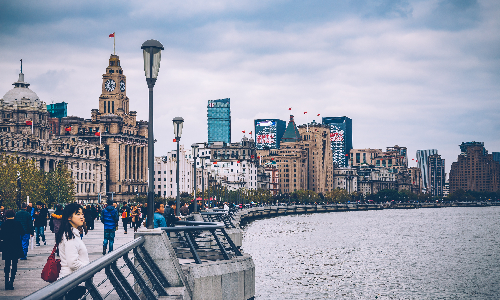
After breakfast, you will start your adventure to Zhujiajiao Water Town, about 50 kilometers southwest of Yu Garden. You can ask whatever you want to know about Zhujiajiao Water Town during your one-hour car trip. Covering about 47 square kilometers, Zhujiajiao Water Town has a history of more than 1,700 years. Similar to Venice in Italy, this ancient town is crisscrossed with numerous waterways. But what you can experience here will be completely different. There are traditional Chinese residences, well-preserved old streets, and ancient bridges waiting for you to discover. Tai’an Bridge is a famous one among them. It was built in the Ming Dynasty (1368-1644) and it is the steepest bridge in Zhujiajiao Water Town. Tai’an Bridge was made of bluestone, with cloud-shaped reliefs on both sides’ bridge railings. “Tai” and “an” respectively means prosperity and peace in Chinese. It is believed that one will have a good luck if he stays on the Tai’an Bridge for a while. So don’t miss it!
In addition to taking an adventure here on foot, you can also explore the whole town by taking a Luoguo Boat. Propelled by a paddle, Luoguo Boat is a kind of long and narrow wooden boat with a small cabin. The boat got its name from a famous Chinese historical figure named Liu Yong of the Qing Dynasty (1636-1912), whose nickname was “Luoguo” (hunchback in English). After Liu’s lifelong friend, Wang Chang retired from the Qing government, Liu paid a special visit to Zhujiajiao Water Town, the hometown of Wang. After hearing about Liu’s arrival, Wang came out of the town to welcome Liu in person. And it was this boat that Wang took to pick Liu up without pomp and circumstance. Although both them were dignitaries of the Qing Dynasty, they were clean-fingered. Such kind of admirable behavior won the respect of the local people. Later, locals called this kind of boat “Luoguo Boat” to express their respect.
After your lunch at Zhujiajiao Water Town, your guide will transfer you to your next destination, Shanghai Tower, which is about 50 kilometers northeast of Zhujiajiao Water Town. It will take you about one and a half hours to get there. During the drive, you can have a rest in the car in preparation for your adventure to the world’s second-tallest building. Looking from outside, Shanghai Tower is like a Chinese dragon spiraling its way up to the sky. Design as such can help strengthen resistance to strong winds. In addition, the 960 foundation piles buried 88 meters underground will ensure that this 632-meter-tall building can stand the test of an 8 magnitude earthquake or strong typhoon. On the other hand, Shanghai Tower boasts the fastest elevator in the world, with a speed of as fast as 20.5 meters per second. Notably, it only takes you less than a minute to reach the Observation Deck on the 118th floor, where you can command a panoramic view of the entire Shanghai. Here you will be surprised that ships on the Huangpu River look as small as one-yuan coins. As for the towering Oriental Pearl Tower, it looks just like a Lego block placed on the floor. After your adventure in Shanghai Tower, your guide will drive you back to the hotel.
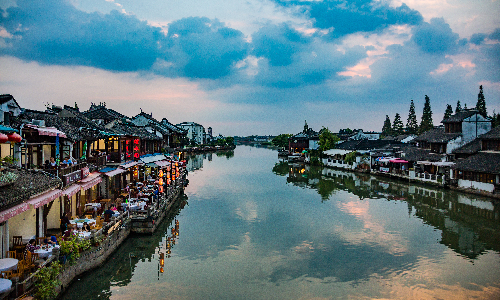
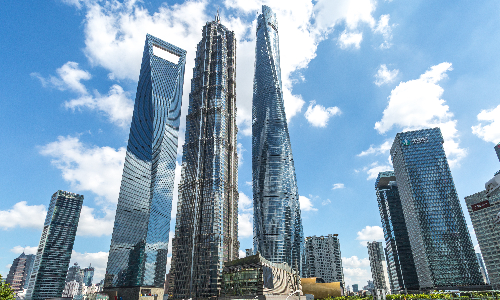
 Hangzhou
Hangzhou After breakfast, your guide will help you check out and drive you to the train station. Then you will take the estimated high-speed train G85 08:00/08:45 to the next destination of your China adventure, Hangzhou, about 190 kilometers southwest of Shanghai.
Upon arrival, you will be transferred to West Lake. It covers an area of about 49 square kilometers. Surrounded by mountains on three sides, West Lake is divided into different sections by causeways. You can take a boat to make yourself closer to the West Lake, in the west part of which you may find yourself surrounded by a huge pool of lotus if you come here in summer. Sitting on the traditional West Lake boat with a sunlight-screening wooden cabin, you will weave through the fragrant lotus with umbrella-like leaves. At that moment, you may feel the indescribable beauty of West Lake and understand why people in China hail West Lake “the heaven on earth”.
After lunch, you will start your adventure to Feilai Peak, a 168-meter-high mountain about 6 kilometers west of West Lake. On Feilai Peak, there are a wide collection of strange-shaped rocks, some of which look like animals, such as a running elephant, a crouching tiger, or a frightened monkey. There is also an interesting story about this mysterious mountain. In the nearby Lingyin Temple lived a crazy monk named Jigong, who defied Buddhist disciplines and hanged around daily. One day, Jigong had predicted that a flying Mountain would fall on the nearby village several days later, which would threaten the lives of the villagers. However, no one in the village believed a single word of this crazy monk. Fortunately, the very day of the mountain’s arrival coincided with the wedding of a villager, who invited all the villagers to his wedding party. On that day, Jigong “kidnapped” the bride in front of everyone to drive them to chase after him. The moment they got out of the village, the mountain fell on the village and turned it into ruins. Afterward, people call this mountain “Feilai Peak”, and “Feilai” means “flew hither” in Chinese.
Your next stop this afternoon will be Lingyin Temple, where Jigong (see above) lived 800 years ago. Lingyin Temple covers about 87,000 square meters and faces Feilai Peak. With Hall of Heavenly Kings, Medicine Buddha Hall, and Main Shrine Hall on its central axis, Lingyin Temple is flanked by Jigong Hall, Hall of the Five Hundred Arhats, and Two Sutra Pillars. You may wonder why the front gate of Lingyin Temple is always kept closed. That is because the front gate of Lingyin Temple only allows the passage of the Emperor. Over 300 years ago, Qianlong, the 6th Emperor of the Qing Dynasty, dressing as a commoner, visited Lingyin Temple after the opening time. After making clear that he was the Emperor, Qianlong ordered the doorkeeper to open the front gate and let him in. However, his order was firmly rejected, because the doorkeeper didn’t believe him. After returning to the imperial palace, Emperor Qianlong issued a royal decree that no one is allowed to pass through the front gate of Lingyin Temple at any time. Nowadays, the royal decree is still observed by the monks in Lingyin Temple despite the fall of the Qing Dynasty.
After your adventure in Lingyin Temple, you will be escorted to the hotel, where you can edit the impressive photos taken today and post them on your Twitter. They will surely get many likes from your friends.
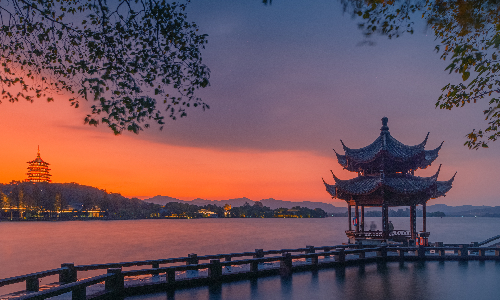
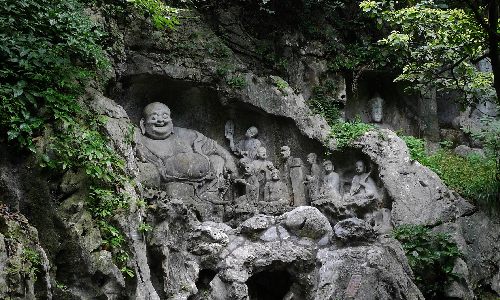
 Huangshan
Huangshan After breakfast, you will take the estimated high-speed train D5577 09:00/10:51 to Huangshan City. After arriving at Huangshan North Station, your guide will drive you to Tunxi Ancient Street, about 15 kilometers southeast of Huangshan North Station. It will take you about half an hour before you get there. During this drive, you are suggested to have a short break in preparation for your today’s adventure. Located in the center of Tunxi District of Huangshan City, Anhui Province (southeastern China), Tunxi Ancient Street extends 1,217 meters in total. With Mount Huang on its north side and Xin’an River on its south side, Tunxi Ancient Street is composed of more than 300 Hui-style buildings, which feature white high walls and black-tiled roofs. In the late Yuan Dynasty (1271-1368), one Anhui merchant named Chen Weizhong built 8 hotels on the bank of Xin’an River, with an aggregate of 47 rooms. From that moment, Tunxi Ancient Street started to take shape. After your adventure in Tunxi Ancient Street, you will be escorted to the hotel and you can spend some private time and have a good rest.
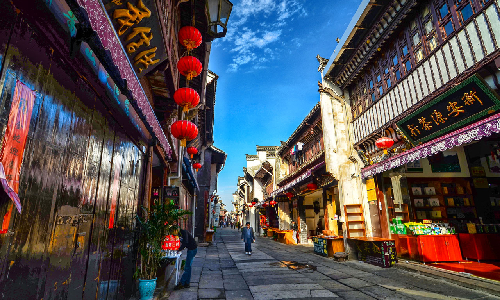
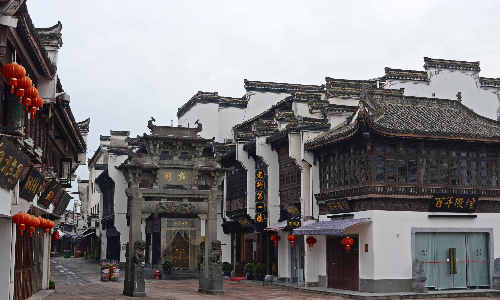
After your breakfast, your guide will help you check out and drive you to Mount Huang, about 60 kilometers northwest of Huangshan city, which will take about one hour. During your time in the car, you can ask some questions about your Mount Huang adventure and enjoy the picturesque scenery outside the window. On Mount Huang, you will marvel at the spectacular views of clouds, crooked pine trees, and peculiar-shaped rock peaks. In 1979, when Deng Xiaoping, the then leader of China visited Mount Huang, he thought highly of its tourism development after being impressed by its magnificent scenery.
Upon arrival, we will first visit the Yungu Temple, which was built in the Ming Dynasty. Around the Yungu Temple, there are many pine trees and bamboos. Besides, many natural attractions deserve your visit. For example, in front of Yungu Temple lies Lingxi Spring, which is a spring pond now. But in the first place, it was just a spring hole, which provided the monks with enough water for daily use. The Lingxi Spring is also called Xizhang Spring (xizhang means tin-made stave). And there is a story about the name Xizhang Spring. Legend has it that Lingxi Spring was created by an esteemed monk who poked a hole into the ground with his tin-made Buddhist stave. Miraculously, at the moment he pulled his Buddhist stave out, a stream of spring water also flowed out ceaselessly. Later, the spring was called Xizhang spring, which had been used for many years.
After visiting the Yungu Temple, you will take a Yungu cable car to Beginning-to-Believe Peak, the best place to appreciate pine trees on Mount Huang. Pine trees on Mount Huang distinguish themselves from others by their grotesque shapes and their extreme growing conditions. They take root in the rocks of the cliffs and receive the baptism of wind and rain. They have different names for their vivid shapes, such as Black Tiger Pine, Dragon Claw Pine, and Flying Dragon Pine, etc. In addition, here you can also see another attraction of Mount Huang, Stalagmite Peak, which is composed of a number of rocks looking like a bush of bamboo shoots.
Then you will walk to Dispelling Cloud Pavilion, a rectangle pavilion covering about 20 square meters. Mount Huang is always hugged with waves of clouds. However, when those clouds reach this pavilion, they will be miraculously dispelled. Hence, people name the pavilion Dispelling Cloud Pavilion. Here you can enjoy a distant view of the West Sea Grand Canyon. Looking down from Dispelling Cloud Pavilion, you will be impressed by its unfathomable canyon, which is like the opening mouth of a gargantuan monster. Looking into the distance, you will find yourself surrounded by the cloud-veiled peaks of different shapes. If you have a careful look at these peaks, you will find that almost every one of them more or less resembles things existing in our life.
Next, you will pass by Flying-over Rock, a wind-eroded rock looking like two separate rocks. A cone-like small rock standing on another large and flat rock gives people the impression that the upper one flying over the bottom one. Then you will be escorted to the hotel on Bright Summit, your guide will recommend you a perfect place to enjoy the sunset cloud. At dusk when the sun goes down, the cloud sea on Mount Huang will be tinted with a riot of color. The “burning cloud waves” joined by the distinctive rock peaks and pines on Mount Huang will present a fantastic picture. And it is highly recommended to capture this precious moment and post these pictures on your Instagram. You will surely get a lot of new followers that day. After that, you are suggested to go to bed early as you will get up early for the sunrise.
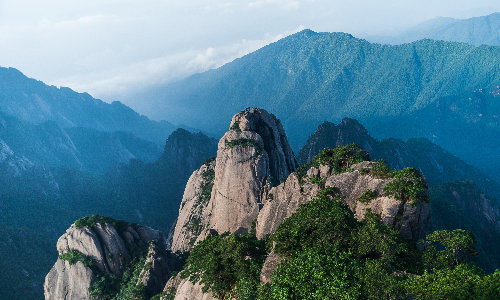
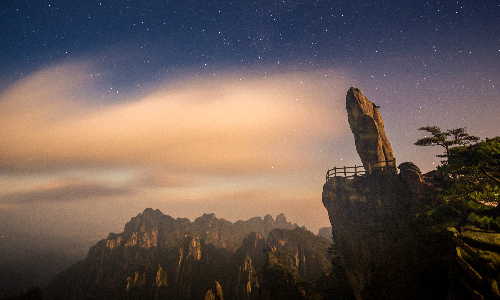
 Beijing
Beijing Before dawn, when you are wakened by your alarm clock and walk out of your hotel, you may find that the hotel lobby is swarmed with many visitors ready for the sunrise. Your guide will lead you to Dawn Pavilion, where you will see the sun inching its way above the skyline. As the sun rises, every part of Mount Huang will seem to be in a mantle of golden light. The snowy cloud sea beneath where you stand together with golden clouds in the sky will present you a stunning scene.
Then you will head to Lion Peak, a peak looking like a crouching lion. It is the best place to see one of the most famous views on Mount Huang, Stone Monkey Watching the Sea. There is a stone looking like a squatting monkey on a mountain north of Lion Peak. Looked from a specific angle, the squatting monkey seems like watching the cloud sea in the distance. When the cloud sea disperses, what the monkey is watching will be replaced by the crop fields in the Taiping County (now Huangshan District). Therefore, the fantastic attraction is also called Stone Monkey Watching Taiping County.
After enjoying Stone Monkey Watching the Sea on Lion Peak, it is time to say goodbye to the magnificent Mount Huang. You will walk to the cable car station and take a cable car down the mountain. Then you will be driven to the train station and take the estimated high-speed train G7498 12:21/13:47 to Hangzhou East Station, where you will be transferred to Hangzhou Airport, about 30 kilometers southeast of Hangzhou East Station. It will take about 45 minutes to arrive at the airport. Next, you will take the estimated flight CA8367 16:00/18:20 to Beijing. Upon arrival, your Beijing local guide will escort you to the hotel, where you can have a good rest in preparation for your new adventure in Beijing.
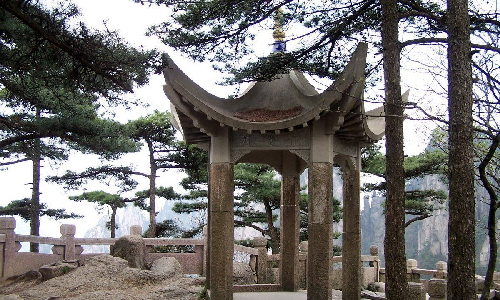

After breakfast, you will visit the world-famous Tian’anmen Square in the center of Beijing. Covering over 440,000 square meters, about the size of 53 football fields, Tian’anmen Square boasts a length of 880 meters from south to north and a length of 500 meters from west to east. This square can accommodate as many as 1 million people for grand gatherings. When you visit the Tian’anmen Square, you will find five bridges, called Golden Water Bridge, in front of Tian’anmen Gate Tower. The one in the middle was called “Imperial Bridge”, which only allowed the passage of the Emperor in the past. The two bridges flanked were called “Royal Bridge”, which only allowed the passage of imperial princes and kinsmen. And the outermost two bridges only allowed the passage of military officers and civil officials of the third rank or higher. Any one violated the rule would be punished as a felony. After the founding of the new China, all these rules have been abolished.
Then you will head to Forbidden City (Closed on Mondays), which was built in the Ming Dynasty. Covering over 72 square kilometers, about the size of 4 Buckingham Palace, Forbidden City had been the royal palace of 24 Emperors in the Ming and Qing Dynasties. Walking on the 600-year-old floor of the Forbidden City, you may notice that there are few, to be accurate, almost no bird landing on the roofs of these exquisite buildings. A question as such may pop into your mind: is there an ancient spell keeping these birds away from the roofs of these majestic buildings? The answer will definitely be no. The stinking bird poop that accumulates on the roof has beset Chinese royal families for thousands of years since the beginning of feudal society. About 600 years ago, when Zhu Di, the third Emperor of the Ming Dynasty, planned to build a new imperial palace, this problem was finally solved. After measuring the size of the birds’ claws, the craftsmen invented a kind of streamline roof ridge that is difficult for birds to take hold of. The choice of smooth glaze tiles together with the design of steep slopes basically means that birds can hardly land on these roofs. Even if bird poop falls on the roofs, it will be cleansed by rainwater. Besides, the roof decoration of beasts on each side of the roof can serve as a deterrent against the birds.
After lunch, you will visit Hutong, a complex of alleys in Beijing. The term, Hutong can be traced back to the Yuan Dynasty, which was ruled by the Mongolians. The pronunciation of “Hutong” is similar to that of “alley” in the Mongolic language. Hutong can be divided into “live” Hutong and “dead” Hutong. The former leads to the outside, while the latter leads to a dead end. If you are not a local, you will absolutely get lost in a maze of Hutong. Therefore, you are suggested to take a rickshaw tour to appreciate the beauty of Hutong. In Hutong, you will find the traditional residences of old Beijing citizens, which feature the layout of a square yard surrounded by four square rooms on four sides.
Your last stop today will be Temple of Heaven, an imperial temple built in the Ming Dynasty. Its size of as large as 2,730,000 square meters tells us the importance of this building. Temple of Heaven was where the Emperors of Ming and Qing Dynasties worshiped heaven and prayed for a good harvest. In the past, the sacrifice rituals were held three times a year. The first ritual was generally held in the Hall of Prayer for Good Harvest on the fifteenth day of the first month in the Chinese lunar calendar, which is also the date of the Lantern Festival. In the fourth month of each year, the second ritual would be held at Circular Mound Altar, praying for adequate rainwater. On the Winter Solstice of the northern hemisphere, the Emperor would worship heaven again at Circular Mound Altar in gratitude for the blessing of both heaven and earth. After visiting Temple of Heaven, you will be escorted to the hotel.
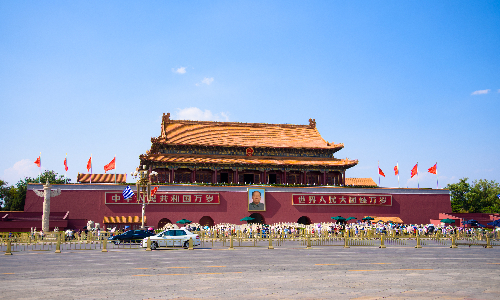
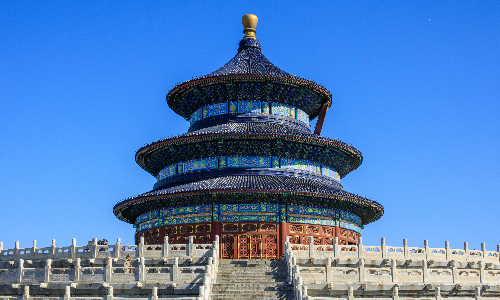
After your breakfast, you will visit Ming Tombs, where 13 emperors, 23 empresses, 2 princes, over 30 imperial concubines, as well as 2 eunuchs were buried. Located in the Tianshou Mountain, about 50 kilometers northwest of downtown Beijing. The whole journey will take you about 1 hour. After arrival, you will visit Ding Tomb, the tomb of Zhu Yijun, the thirteenth emperor of the 16 emperors of the Ming Dynasty. You may wonder why there were only 13 emperors buried in Ming Tombs since an aggregate of 16 emperors had reigned. The first one missing is Zhu Yuanzhang, the founder of the Ming Dynasty. During his reign, the capital of the Ming Empire was Nanjing in eastern China, where his Xiaoling Mausoleum is located. The second one missing is Zhu Yunwen, Zhu Yuanzhang’s grandson, who died in the coup led by his uncle, during whose reign, both Forbidden City and Temple of Heaven were built. The last missing emperor is Zhu Qiyu, the seventh emperor of the Ming Dynasty, who succeeded his elder brother as the emperor when his elder brother was held in captivity by the enemy. The interim emperor was unwilling to return the throne when his brother was released one year later and confined him. About seven years later, his elder brother launched a coup against him and succeeded. Zhu Qiyu died in confinement for unknown reasons one year later.
In the afternoon, you will start your Mutianyu Great Wall adventure after taking a one-hour car journey. Mutianyu Great Wall is located at about 50 kilometers northeast of Ming Tombs. Here, you will take a cable car to explore the splendid Great wall in China, which boasts a length of as long as 5,400 meters. Mutianyu Great Wall was built in the Ming Dynasty on the ruins of the Great Wall built in the North Qi Dynasty (550-577). The architectural masterpiece attracts many famous visitors, including the former British Prime Minister John Major and former president of the United States Bill Clinton. After your Great Wall adventure, you will take a cable car getting down the Great Wall.
After your Great Wall adventure, you will be escorted to the hotel, which is located at 78 kilometers south of Mutianyu Great Wall. It will take you about one and a half hours to get to your hotel. On the way to the hotel, we will stop nearby the Water Cube (National Aquatic Center) and the Bird Nest (National stadium). You can take some pictures of them.
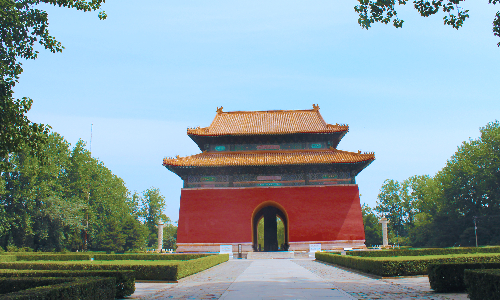
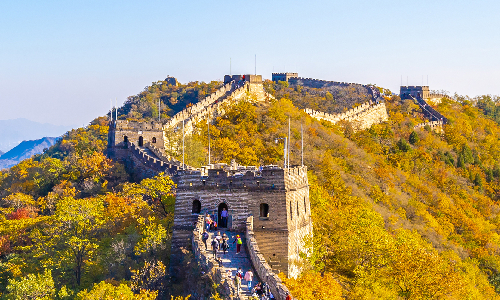
After breakfast, your guide will escort you to the airport according to your flight schedule, which marks the completion of your China adventure. Your guide will wave you goodbye, and you will take the flight home with a good memory of China.
Editor: Yuxin Zhou
Proofreader: Yan Liu
| City | Five Star hotel list | Four Star hotel list |
|---|---|---|
| Shanghai | Ocean Hotel Shanghai | Courtyard by Marriott Shanghai Central |
| Hangzhou | Landison Plaza Hotel | Best Western Plus Meiyuan Hotel Hangzhou |
| Huangshan | Huangshan International Hotel | Huangshan International Hotel |
| Beijing | Sunworld Dynasty Hotel Beijing Wangfujing | Sunworld Hotel Wangfujing |
 |
![]() About your child or infant, please contact us for a discounted price.
About your child or infant, please contact us for a discounted price.



We started with a few days in Beijing & ended in Shanghai, from where we visited the Forbidden City and Great Wall. In between we visited Terra Cotta Warriors Museum, Panda Base, Shanghai Disneyland.

We had a wonderful holiday in China which will remain long in the memory. China is a breathtakingly beautiful country full of splendid temples and palaces, mountains and rivers, peaceful rural scenes and bustling shopping streets.
 QUICK ENQUIRY
QUICK ENQUIRY